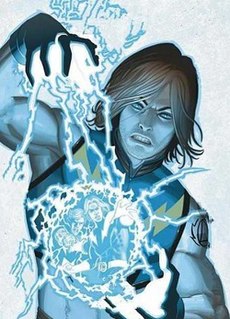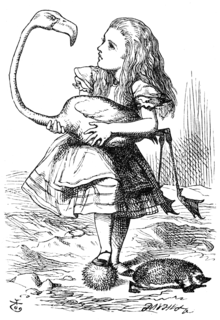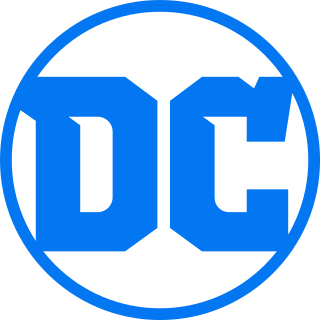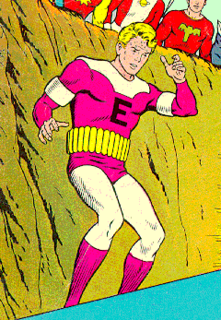History
The White triangle group believes that Daxamites are superior to all other beings and that contact with non-Daxamite races is "unclean". Those raised in White Triangle communities are deliberately kept ignorant of the basics of biology and other sciences, so as to maintain their belief in the racial creeds of their society. [2] They are also taught that the story of the Daxamite hero Valor "seeding" many of the humanoid races of the galaxy from a common ancestral group (Earth humans) is a lie. [3]
Biology is the natural science that studies life and living organisms, including their physical structure, chemical processes, molecular interactions, physiological mechanisms, development and evolution. Despite the complexity of the science, there are certain unifying concepts that consolidate it into a single, coherent field. Biology recognizes the cell as the basic unit of life, genes as the basic unit of heredity, and evolution as the engine that propels the creation and extinction of species. Living organisms are open systems that survive by transforming energy and decreasing their local entropy to maintain a stable and vital condition defined as homeostasis.

Lar Gand, known mainly as Mon-El, is a fictional character appearing in American comic books published by DC Comics, commonly in association with the Legion of Super-Heroes, Superboy, and Superman. The character has been reinterpreted over the years, but in all versions, he serves as a hero with abilities similar to those of Superman, sometimes serving as a substitute for him.
The White Triangle's isolationist and xenophobic doctrine spread to several worlds, including Earth. Finding the very concept of the recently formed United Planets abhorrent, the White Triangle set about plotting its destruction. Blaming industrialist R.J. Brande's stargate technology for making the UP possible, the Triangle ordered one of their followers on Earth, Roderick Doyle (Brande's business partner), to have Brande assassinated during a trip to Earth. The assassination was foiled by Rokk Krinn, Imra Ardeen and Garth Ranzz, three teenagers who were on the same ship. Ironically, seeing teens from disparate worlds working together inspired Brande to form the Legion of Super-Heroes as a living symbol of the UP's ideals. [4] The Triangle provided Doyle with a bomb to make a second attempt on Brande's life, hoping to kill him, the newly formed Legion and the United Planets general assembly in a single stroke, but the Legion foiled their plans again [5] and a mental probe of the assassins revealed Doyle's role. [6]

Rene Jacques "R. J." Brande is a fictional DC Comics character in the 30th and 31st centuries with the Legion of Super-Heroes. He first appeared in Adventure Comics #350 and was created by E. Nelson Bridwell.

Saturn Girl is a fictional superheroine appearing in American DC comic books. A talented telepath from the 30th century, Saturn Girl is a founding member of the Legion of Super-Heroes. Imra's "Saturn Girl" title refers to her homeworld of Titan, the largest moon of the planet Saturn.

Garth Ranzz, also known as Live Wire and Lightning Lad, is a fictional comic book superhero appearing in books published by DC Comics, usually those featuring the Legion of Superheroes, a 30th and 31st century group of which he is a founding member. He has the superhuman ability to generate electricity, usually in the form of lightning bolts.
Upon Doyle's failure, the Triangle recruited mercenaries [7] to release the prisoners of a supermax private prison called Planet Hell, hoping to use the convicts to destroy the UP and as expendable shock troops. Again, the Legion foiled the plot with the aid of the Workforce. [8]
A private prison, or for-profit prison, is a place where people are imprisoned by a third party that is contracted by a government agency. Private prison companies typically enter into contractual agreements with governments that commit prisoners and then pay a per diem or monthly rate, either for each prisoner in the facility, or for each place available, whether occupied or not. Such contracts may be for the operation only of a facility, or for design, construction and operation.
The Workforce is a fictional semi-heroic-super-team, in DC Comics' Post-Zero-Hour-Legion-of-Super-Heroes, continuity. And was introduced in Legion of Super-Heroes#64.
Throughout all these events, the existence of the White Triangle remained secret. This changed with the drafting of Laurel Gand into the Legion. Laurel, codenamed Andromeda, was raised in a White Triangle community on Daxam, and her indoctrinated disdain for all non-Daxamites often interfered in her ability to perform as a Legion member.

Laurel Gand is a fictional superheroine in the 30th/31st-century DC Comics universe, and a member of the Legion of Super-Heroes. She was created as a replacement for Supergirl in post-Crisis on Infinite Earths Legion continuity. She was also inspired by elements of Superman's supposed descendant Laurel Kent.
Daxam is a fictional planet within the DC Universe. It is home to a race called the Daxamites, who are descended from Kryptonian colonists.
On an outing with several of the female Legionaires, she witnessed an assault on an aquatic alien by three thugs. Laurel insisted on handling them alone, but upon capturing them, she saw that they wore White Triangle pendants and therefore let them off with a warning. [9] Later, the same three thugs would assault the Legionnaire Luornu Durgo, nearly killing her. [10] The investigation into the attack would lead the Legion to discover the Triangle's existence. Feeling guilty over Durgo's attack, Laurel confronted the thugs, only to have them poison her with lead, a substance fatally toxic to Daxamites even in trace amounts. She was cured by Brainiac 5, who forced her to confront the fact that he wasn't her inferior before giving her the antidote. Afterwards, Shrinking Violet discovered a White Triangle necklace in her room. [3]

Triplicate Girl is a fictional character, a superhero in the 30th and 31st centuries of the DC Comics Universe and a member of the Legion of Super-Heroes. She has also had the aliases Duo Damsel, Triad, Una, Duplicate Damsel and Duplicate Girl.

Brainiac 5 is a fictional character who exists in the 30th and 31st centuries of the DC Universe. He is a long-standing member of the Legion of Super-Heroes. Brainiac 5 is from the planet Colu.
Meanwhile, the Legion began to link the White Triangle to increasing incidents of racial violence, while a direct action cadre of Daxamite Triangles began to destroy stargates across the galaxy. [11] This culminated in a larger group of Daxamites laying waste to the planet Trom, whose population of peaceful transmuters enabled R.J. Brande to develop the stargate technology. [12]
Cosmic Boy attempted to have Andromeda expelled from the Legion, but Ambassador Roxxas, who was secretly the leader of the White Triangle, convinced the UP President to allow her to remain. He then bullied Andromeda into giving him the anti-lead serum. Taking it himself and giving it to four other Daxamites, Roxxas proceeded to cause mass destruction on Earth. The serum required tailoring to the genetics of the individual being cured, so by taking a formulation make for Gand, the other Daxamites were driven insane. The Legion managed to stop the four Daxamites with the aid of Jan Arrah, the last surviving inhabitant of the planet Trom, while Andromeda herself defeated Roxxas, seemingly at the cost of her own life, though she would be discovered alive later. [13]
Following Roxxas' apparent death, the Legion and the Science Police went on a galaxy-wide hunt for all active White Triangle cells. [14]
The White Triangle organization has not been seen in the most recent Legion continuity reboot ("Threeboot").












